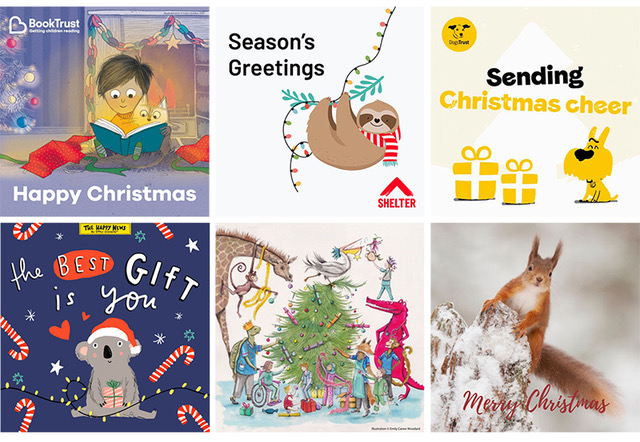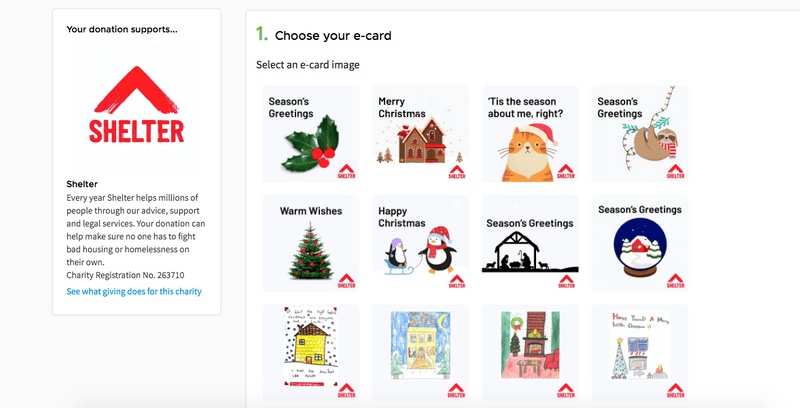Top tips for making a success of charity Christmas cards

Charity Christmas cards are a long-standing tradition but how can you ensure yours are a success? Here are some tips for planning, choosing the creative, and promoting them.
Cards for Good Causes has a 60 year history of selling Christmas cards for charities of all sizes, via its seasonal pop-up shops throughout the UK as well as its site. In the last 10 years, it has raised over £40 million for charity.
Corinne Allen, its Head of Marketing and Communications, shares some top tips:
1. When to Start Planning:
Our Christmas card planning starts in January and we are talking to publishers and putting in orders before the spring, ready for the season. You really do need to start this early to ensure that you have everything prepared in time for the busy festive period. Most charities will have 8 new designs for the season every year.
2. What card trends are popular
Animals and the natural world continue to be a firm favourite with highland cows and sheep being particularly popular. Also, hares and any designs featuring a robin do extremely well. Local scene cards are also trending, especially those that feature London scenes such as ice skating at Somerset House. People want to see designs that are more personal and give that local community feel. With Christmas being about tradition, a variety of religious designs also perform well. Specifically, those that show a nativity scene or angels.
One trend that has really grown over the past few years is the lino cut print style design. One of the bestsellers for this year is a winter murmuration card, which is a reproduction of a lino print from an artist called Alison Headley.
When choosing cards, people are becoming far more eco-conscious and we have been using recyclable packaging, with all cards also glitter-free for the last three years.
3. When the season starts
We start to see searches for Christmas cards increase as early as August and this continues throughout September. By mid-October, sales ramp up significantly and this is when we open all of our seasonal pop-up shops. November is an incredibly busy month but this starts to subside as the final postal date looms. By the beginning of December, we see our gifts start to sell well and be a key focus.
4. How to promote
Charities will have a Google ad grant for paid ads which they can use some of to help promote their charity Christmas cards and Google shopping ads are now free which can feed through to your online shop. Your prime target market is those on your database, as they are already a warm audience.
Do ensure that you are regularly promoting your cards on your social media channels and any e-newsletters going out in October and November. Also, use any partnerships that you may have to help you to promote to their audiences too (following GDPR compliancy of course).
5. Online vs. offline
With Covid-19, online sales have increased significantly and this rose to 50% of our sales last year. Previous to Covid, our online sales were just 3% of our business so this is an incredible shift. We expect this to drop a little this year to be about 35-40%. Do ensure your website page is optimised with good, descriptive copy to improve SEO and you have good, clear imagery. Many customers still like to physically see card designs though so do ensure that you are selling your charity Christmas cards in any charity shops that you may have. Our customers certainly still like to go to our pop-up shops in the heart of their local communities.
6. How much is raised
This depends on how low you keep your production and distribution costs. There is a real appetite for Christmas cards to be from a charity and there is always a lot of discussion about how much goes back to the charities. Cards for Good Causes runs as a not-for-profit, so gives 70p back in every £1, which is significantly higher than the supermarkets. Many customers are now aware of this and will come to us or a charity direct but we need to all continue to educate customers about this.
Charity e-cards
Charity fundraising platform DontSendMeACard.com reports that donations in lieu of cards have doubled through its site year-on-year for the past four years, with a big increase in repeat donors.
Over 1400 charities have registered from the UK, USA, Australia, Ireland, and Canada. Through the fundraising dashboard charities can upload their own e-card designs.
Its founder, Alex Furness, gives his tips for charities creating e-cards:
1. Keep the messaging and imagery light-hearted, bright, fun – they are cards that people will send after all.
2. If your charity is associated with an artist or illustrator you can ask them to contribute card designs. Here’s a great example for 52 Lives with cards illustrated by Emily Coxhead:
3. Don’t be afraid to inject some humour in. If the recipients like the e-cards they’ll then go on to support your charity too. Great example by Somerset Wildlife Trust:
4. This is one project where the charity can go off on a creative tangent a bit more – the designs don’t have to be overly cause-related/driven. For example Shelter have a festive sloth and a grumpy cat along with designs that have an underlying theme of housing too.

5. People love the convenience offered by e-cards. So if you do leave it to mid-December to publish your card designs you can still raise significant amounts through to 24 December, especially around the postal deadline.
For more ideas on creative, here’s a selection of charity Christmas cards







